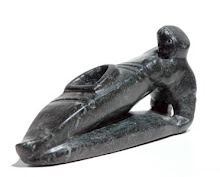Note: The pictures below were taken by Luis, from Ponferrada, who kindly allowed me to use them.
Easter 2008 brought a diversity of fresh kayaking experiences of the good (very good, actually) kind packed in four days spent in the Santa Marta de Ortigueira area in Galicia, northwestern Spain.
I met new fellow kayakers, making what I hope will become new friends, and got first hand contact with the
AGKM (Asociación Galega de Kaiak de Mar), an interesting and promising initiative in the national sea kayaking scene. My recently finished first Greenland paddle got its first use in saltwater. For the first time, I could lay my hands on SOF boats, a Greenland-style kayak made by one of my woodworking gurus,
Paco García, and an Aran currach that travelled all the way from Barcelona, and I paddled in new, very nice places.

Under AGKM's gentle wing, what initially was to be just a gathering of friends at Ortigueira, quickly and spontaneously grew into something quite large that included semi-strangers like me, a surf-kayak clinic, a Greenland paddle-making workshop and Greenland ropes. In spite of this, the event very purposefully stuck to its original informal nature and a "We are all organizers here" motto. Of course, some people actually worked while I, for example, contributed by having a jolly good time, but I believe the prevalent spirit, a sort of gently-steered anarchy, was indeed the intended one. It worked remarkably well.
It was my first kayaking exposure to our northern sea. That stretch of Atlantic Ocean that we call Mar Cantábrico (Cantabrian Sea) and others the southern end of the Bay of Biscay. It is a beautiful coast. Over most of its length, it is conveniently sprinkled with
rías, river inlets that afford protected waters where guys like me can still enjoy very nice outings when conditions out there get hairy. In Galicia, the coast's western end and where we were, those inlets become even more frequent and substantial. It is also reasonably dotted by villages (often quaint and picturesque) ports where you can stop for refreshment and good food. It is truly a wonderful area for sea kayaking.

As first exposures go, it was a tad limited, though, as the weather did not fully cooperate. For me, F6-7 winds and truly big seas (4-7 m) accompanied by rain and hail squalls made paddling unappealing in the inlets and pretty much suicidal in the ocean on Saturday and Sunday. Fortunately, there was the paddle-making shop and a lovely piece of red cedar to keep me happily busy.
On Thursday, we all paddled together and poked our collective nose out of the Ortigueira inlet from the small port of Espasante. Conditions, though milder than they would become later during the weekend, were not exactly comfortable (F4-5, about 2-3 m breaking waves) for a group of mixed skill levels such as we were and we soon returned to sheltered waters. Lesson learned, next day we split according to our abilities and daring. A minority faced F5 (later 6) wind and 3-4 m waves in an excursion along the coast. Prudently, I went with the majority and the currach for a more sedate trip down the very pretty O Barqueiro inlet to the beautiful port of Bares taking the Greenland stick out for its first trip.

Bares happens to be the northernmost port in Spain and there are occasional statements that it is also the oldest one still in operation. Its megalithic jetty is often dated to the VIIIth century BCE and attributed to either Phoenician traders or, less commonly, local peoples. However, recent scholarships is critically reviewing those claims and a
consensus on a roman origin may be emerging. In any case, its an intriguing and impressive structure that has formed the beach where we disembarked for a beer and a bite of something good in a nearby tavern. We returned with a helping high tide, winds increasing to the point of occasional annoyance and growing esteem and comfort with my Greenland paddle on my part. By the end of the trip, I was totally hooked on it. For a good while, I paddled near the currach watching it move against a backdrop of cliffs, woods, secluded beaches, coves and small fishing villages in the opposite shore and having just the greatests of times.
It is truly a wonderful area for sea kayaking.

 In one of the Aubrey & Maturin series novels by Patrick O'Brian (of which I am a devoted fan), the tender Ringle, a schooner (possibly a topsail schooner, as she was of the kind known as Baltimore clippers) of Jack Aubrey's property appears at a certain moment crossing a bay closed to the north by the Cape of Bares. Commanded as usual by Midshipman William Reade and carrying Dr. Maturin, his daugthter and his fortune, Ringle, finds herself closely pursued by a strong French privateer, the three-masted lugger Marie Paule. To avoid boarding and capture, Ringle, masterly skippered by Reade and Aubrey's coxswain, the magnificent Barrett Bonden, has to literally sail a biscuit's toss from the dangerous cliffs and rocks of the Cape.
In one of the Aubrey & Maturin series novels by Patrick O'Brian (of which I am a devoted fan), the tender Ringle, a schooner (possibly a topsail schooner, as she was of the kind known as Baltimore clippers) of Jack Aubrey's property appears at a certain moment crossing a bay closed to the north by the Cape of Bares. Commanded as usual by Midshipman William Reade and carrying Dr. Maturin, his daugthter and his fortune, Ringle, finds herself closely pursued by a strong French privateer, the three-masted lugger Marie Paule. To avoid boarding and capture, Ringle, masterly skippered by Reade and Aubrey's coxswain, the magnificent Barrett Bonden, has to literally sail a biscuit's toss from the dangerous cliffs and rocks of the Cape.










